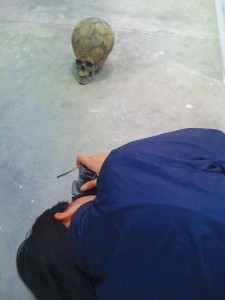« Features
Push to Flush: Culture of Interpassivity
By Paco Barragán
I remember reading Culture of Complaint by Robert Hughes sometime toward the end of the 90s.1 It’s still a very valid working title with an interesting perspective on American society by a still well-known Australian arts writer-his interviews on YouTube with Ronald Lauder and the Mugravi are a must see.
Witty, ironic, and at moments reactionary, the book offers a poignant reminder of the excessive linkage of political correctness and multiculturalism. Now, hardly a decennia of this new century has passed when this culture of complaint is constipated with a pervasive sense of “interpassivity.” We complain more and more because our society is absurd and we feel unfulfilled, dissatisfied, and anxious.
Let’s face it: (neo)capitalism has made us all “interpassive.” I wrote about it a while ago when I stated that collectors these days love the noble art of karaoke, which on its turn makes them interpassive. Just look around you: most collectors are buying the same stuff over and over again-but let’s not be too hard on them if we look at the artist list of most leading biennales!
Austrian cultural critic Robert Pfaller understands “interpassivity” as a concept opposed to “interactivity”, which entails “a delegated pleasure or consumption.”2 One of the examples that Pfaller uses to exemplify his theory is the traditional taping of television program on a video recorder while the person is away; the program is recorded and then hidden away on a shelf without ever being watched again. How many videotaped series and programs do we have on our shelves that we haven’t watched again for years and years? Another pertinent example that Pfaller mentions in the same text, borrowed from Slavoj Žižek, is related to the American sitcoms that come with a laugh track included and makes thus viewers “interpassive.”
Nowadays in our media and technology-driven society, interpassivity is all around us. It’s sufficient to go to a museum like MoMA, visit a biennial like Venice, or stroll around an art fair like ABMB to see an even more exacerbated version of this phenomenon: thousands of people (especially youngsters) do not even look directly at the artwork, but rather enter the exhibition space with their digital or video camera or their iPhone and contemplate the artwork through their lens or display.
Gilles Lipovetsky and Jean Serroy have already explored in various books how the global screen defines contemporary times and how it deregulates culture’s time-space. This is yet another form of totalitarian fascist superstructure that provides nonstop canned, popular products, easy to understand, requiring no intellectual effort whatsoever, making us as spectators dumber and more passive.
I would like to push the envelope here a little bit further and argue that we are interpassive citizens in general, and in the art world in particular. Let me explain myself. The problem with the art world is that we are just much too focused on ourselves and too much disconnected from society. In the Arab Spring, the 15-M indignados movement in Spain, or now at Occupy Wall Street, there is hardly any important artistic presence. We like to sign manifestos-read Ai Wei Wei–post videos on YouTube or Facebook and send messages via Twitter.
And this is pure interpassivity, as we allow these social media to speak for us. But to the politicians, social media-representation–don’t really care, as they are only impressed and scared off by the physical presence-reality–of the citizen out on the streets and reclaiming public space, as happened in Madrid at Plaza del Sol or at Zuccotti Park. Maybe we should be honest for once: we consider ourselves the intellectual avant-garde of the system, but occupying the streets and going to the barricades doesn’t fit our sense of radical-chicness because our Prada shoes could get spoiled!
See now what Hughes wrote back then: “The academic left is more interested in race and gender than in class. And it is very much more interested in theorizing about gender and race than actually reporting on them. This enables its savants to feel they are on the cutting edge of social change, without doing legwork outside of academe” (Hughes 76). We could add that the major difference now is that it has become a real class struggle between the upper classes on one side and the middle and working classes on the other.
“The most celebrated,” writes Hughes once again, “widely reproduced and universally recognizable political painting of the 20th century is Picasso’s Guernica, and it didn’t change Franco’s regime one inch or shorten his life by so much as one day. What really changes political opinion is events, argument, press photographs, and TV.” But art has lost that battle against television, cinema, advertising, and music, and its autistic, elitist, and bourgeois premises are unable to connect with real social or political movements.
NOTES
[1] Hughes, Robert. Culture of Complaint. New York: Oxford University Press, 1993.
2 Pfaller, Robert. “Backup of Little Gestures of Disappearance: Interpassivity and the Theory of Ritual.” Journal of European Psycoanalysis: Humanities, Philosophy, Psychotherapies 16 (2003). <http://www.psychomedia.it/jep/number16/pfaller.htm>



































